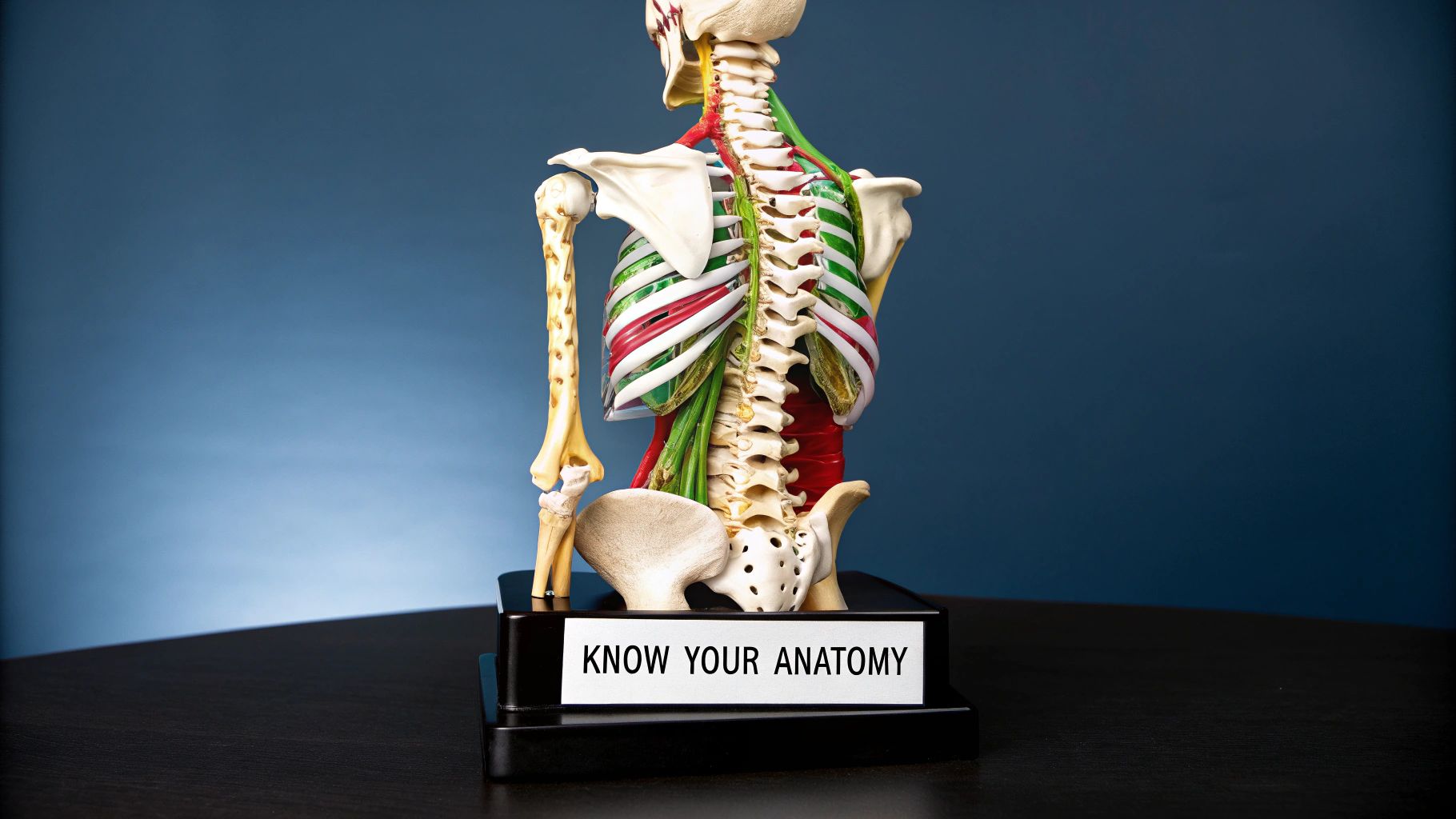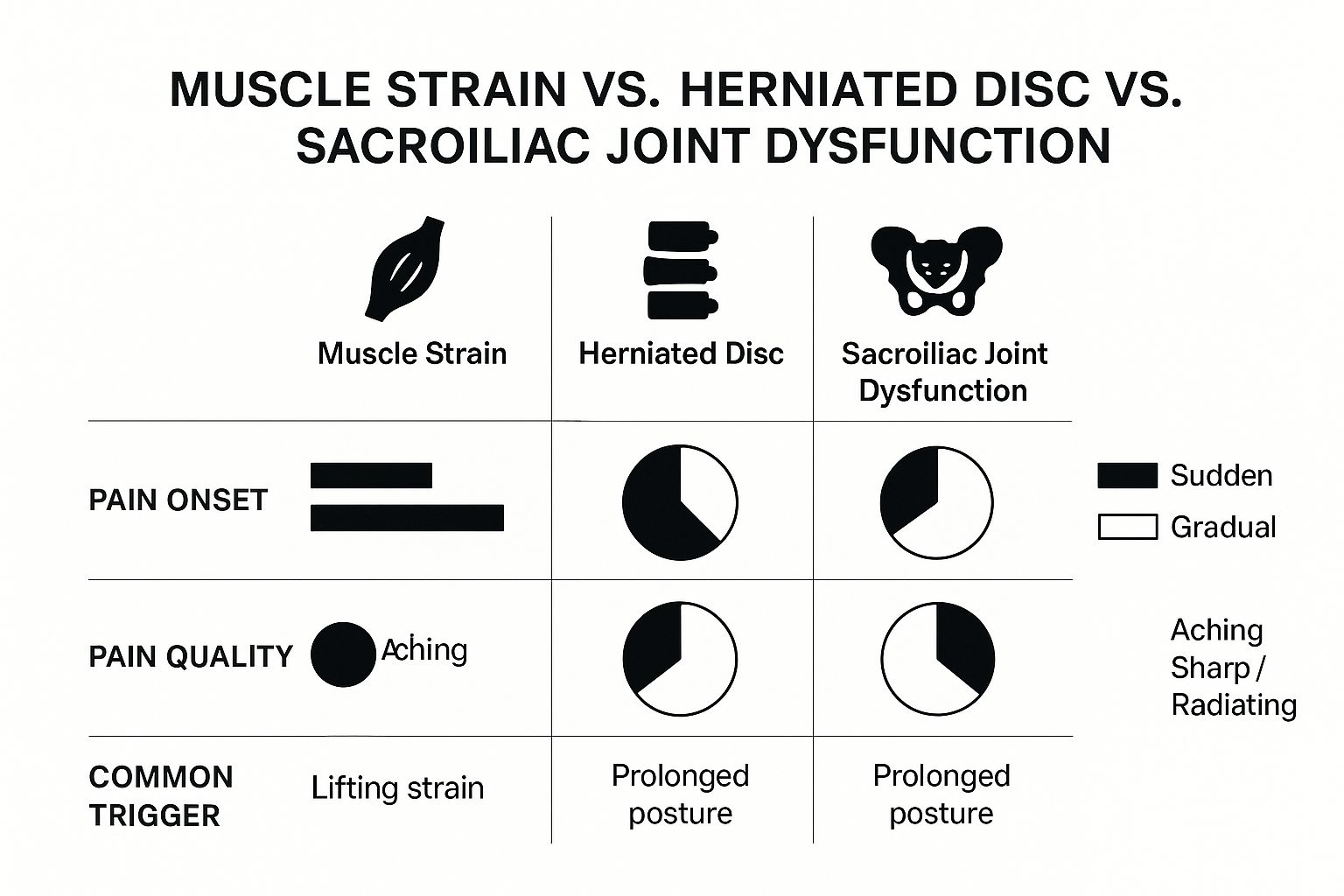If you’ve ever felt that nagging, sharp, or aching pain concentrated in your lower right back, you know how unsettling it can be. It's natural to wonder what's going on. Most of the time, the culprit is a simple muscle strain, but that same spot can also be a warning signal from deeper structures, like your right kidney. Figuring out the potential sources is the first real step toward getting relief.
Unpacking the Causes of Lower Right Back Pain
Pain on the lower right side of your back is an incredibly common complaint. You're definitely not alone in this. Low back pain is a massive global health issue, affecting an estimated 619 million people back in 2020, and it remains the single leading cause of disability across the world. Experts project that number could swell to a staggering 843 million by 2050. You can explore more on these global health trends from the Institute for Health Metrics and Evaluation.

When the pain is stuck on one side, it acts like a clue, pointing you toward a specific area of your anatomy. Think of your lower right back as a busy intersection where muscles, nerves, bones, and even vital organs all cross paths. A problem with any one of these components can create that distinct, one-sided ache you're feeling.
Distinguishing Between Potential Sources
The first order of business in decoding your pain is to figure out whether it's coming from your body's "scaffolding"—the muscles and bones—or from an internal organ. Musculoskeletal pain is by far the most frequent reason and usually involves the structures that help you move and stay upright.
Some of the usual musculoskeletal suspects include:
- Muscle Strains: That classic "I lifted something wrong" injury from overstretching or tearing a muscle.
- Ligament Sprains: Similar to a strain, but this affects the tough, fibrous bands that connect your bones.
- Spinal Issues: Things like a herniated disc or spinal stenosis can pinch a nerve root specifically on the right side.
- Joint Dysfunction: The sacroiliac (SI) joint, where your spine meets your pelvis, is a common source of one-sided pain.
Now, on the other hand, pain can be "referred" from an organ located in that quadrant of your body. This is less common but crucial to consider, especially if the pain is severe or you have other symptoms along with it.
Key Takeaway: Pain on just the lower right side of your back is usually a mechanical issue related to muscles or joints. However, because important organs like the right kidney and appendix are nearby, it's vital to pay attention to any other symptoms that could signal an internal problem.
To help you start sorting through the possibilities, I've put together a quick reference guide. This table breaks down potential causes and how the pain typically feels, which can help you connect your symptoms to a possible origin.
Quick Guide to Potential Causes of Lower Right Back Pain
This table categorizes potential sources of pain to help readers quickly differentiate between common musculoskeletal issues and more serious internal organ-related conditions.
| Pain Source Category | Common Causes | Typical Pain Characteristics |
|---|---|---|
| Musculoskeletal | Muscle strain, ligament sprain, herniated disc, SI joint dysfunction | Often described as a dull ache or sharp pain that gets worse with movement and feels better with rest. |
| Internal Organs | Kidney stones, kidney infection, appendicitis, ovarian cysts (in women) | Tends to be a deep, constant, and sharp pain that doesn't change with movement. May come with fever, nausea, or changes in urination. |
Remember, this is just a starting point. How the pain behaves—whether it's sharp or dull, constant or intermittent, and whether it changes with your position—provides important clues that can lead to an accurate diagnosis and effective treatment.
A Look Inside: The Anatomy of Your Lower Right Back
To get to the bottom of that nagging back pain on your lower right side only, it helps to understand what's actually going on under the skin. Think of this area not just as a spot that hurts, but as a complex and layered neighborhood where bones, muscles, nerves, and even organs all live and work together.
A single point of pain can have many different origins, so let's take a quick tour of the structures that could be sending you those pain signals.

Having a basic mental map of this area can make a world of difference when you're trying to figure out the source of your discomfort.
The Spine: Your Body's Central Pillar
Your spine is the structural core that supports your entire upper body. The lower part of this column is made up of five large bones known as the lumbar vertebrae.
Imagine these vertebrae are like sturdy building blocks stacked one on top of the other. Tucked between each one is a tough, gel-filled cushion called an intervertebral disc. These discs are your body's natural shock absorbers, preventing the bones from grinding against each other and giving you the flexibility to bend and twist. When a disc on the right side bulges or herniates, it can easily press on a nerve, causing that sharp, localized pain.
Surrounding this bony column is a web of muscles and ligaments that provide strength and stability. A very common culprit for one-sided back pain is a deep muscle called the quadratus lumborum (QL), which connects your lowest rib to the top of your pelvis. If you strain your right QL from overuse, an awkward movement, or even just poor posture, it can lead to a persistent, deep ache.
When It's Not Your Back at All: The Internal Organs
What often makes lower right back pain so confusing is that it can be "referred" from one of your internal organs. This means the problem isn't in your spine or muscles, but the pain signals are showing up in your back.
Several key organs are located nearby:
- The Right Kidney: Your right kidney is situated just below your rib cage, toward your back. A kidney infection or a painful kidney stone can cause a sharp, intense pain right in that area.
- The Appendix: While appendicitis is famous for causing abdominal pain, the inflammation can sometimes radiate to the lower right back.
- The Colon: Part of your large intestine, the ascending colon, runs up the right side of your abdomen. Inflammation or irritation here can sometimes be felt as back pain.
For women, it's also important to consider the reproductive organs. Problems with the right ovary or fallopian tube, like an ovarian cyst or an ectopic pregnancy, can manifest as a deep, constant ache in the lower right back and pelvis.
By visualizing these different layers—bones, discs, muscles, and organs—it becomes clearer why getting an accurate diagnosis is so crucial. A pulled muscle requires a very different approach than a kidney stone. This anatomical knowledge empowers you and your healthcare provider to ask the right questions.
It's also why integrative therapies can be so effective. A practitioner can use this same understanding to identify specific acupuncture points for back pain that target either muscular tension or the function of a nearby organ, giving you a more holistic path to relief.
Decoding Common Musculoskeletal Causes
When you're dealing with back pain on the lower right side only, the source is almost always found within the complex framework of your musculoskeletal system. Think of it as the body's scaffolding—a network of muscles, bones, ligaments, and joints. Just like the frame of a house, it can suffer from wear, tear, and unexpected damage from our daily lives.
More often than not, this one-sided pain is a mechanical problem, not a red flag for a serious internal disease. The culprit is often something simple: pushing it too hard at the gym, lifting a heavy box the wrong way, or even just sleeping in a weird position. Let's break down the most common mechanical reasons for that specific ache.
The Familiar Ache of a Muscle Strain
A pulled or strained muscle is by far the most frequent reason for localized lower back pain. It’s what happens when you overstretch or tear the muscle fibers in your back. This can happen in an instant—like when you twist awkwardly to catch something you dropped—or it can sneak up on you over time from repetitive movements.
Picture the muscles in your lower back as a bundle of rubber bands. If you yank one too hard or too fast, it can fray or even snap. This injury sets off an inflammatory response, which brings on the pain, stiffness, and sometimes muscle spasms right where the strain occurred.
When Spinal Discs Create Focused Pain
Your spine is much more than just a stack of bones. In between each vertebra are soft, gel-like discs that act as shock absorbers. A herniated disc happens when that soft inner "jelly" pushes out through a tear in the disc's tough outer layer.
If this rupture occurs on the right side of your lower (lumbar) spine, it can put direct pressure on a nerve root. This nerve compression is what causes that pinpointed pain, and it often feels much sharper and more relentless than a simple muscle ache. Sometimes, the pain doesn't stay put; it might travel down into your buttock or leg—a classic sign of sciatica.
This infographic can help you start to tell the difference between these common culprits based on their typical signs.

As the chart shows, a sudden, aching pain that starts after lifting something heavy often points to a muscle strain. In contrast, sharp, radiating pain that develops more slowly might suggest a disc issue is at play.
Joint Dysfunction and Arthritis
Don't forget that your spine is also a series of interconnected joints that give you the ability to move. Two types of joints in the lower back are notorious for causing one-sided pain.
-
Sacroiliac (SI) Joint Dysfunction: Your SI joints are the powerful joints connecting your spine to your pelvis on both sides. If the right SI joint gets inflamed or isn't moving as it should, it can create a very distinct pain felt in the lower right back and buttock.
-
Facet Joint Arthritis: Between each of your vertebrae are small, stabilizing joints called facet joints. Just like your knees or hips, these joints can break down over time, leading to osteoarthritis. When this wear and tear happens on the right side of your lumbar spine, it can cause a chronic, localized ache and stiffness. You can learn more about managing arthritis in the spine and its treatment options.
These joint-related problems usually cause a dull, nagging pain that gets worse when you stand for a long time or make specific movements, like twisting or getting out of a chair.
Knowing whether your pain is coming from a muscle, a disc, or a joint is the first real step toward getting relief. Each of these issues responds best to a different approach, from targeted stretches and physical therapy to more focused medical treatments.
When your lower right back pain isn’t what it seems, it’s time to look deeper.
While most aches and pains in your lower right back point to a muscle pull or a spinal issue, sometimes the real problem lies with an internal organ. This is what doctors call "referred pain," a fascinating but painful phenomenon where trouble in one area of your body makes itself known somewhere else entirely.
Think of it like a crossed wire. A problem in an organ like your kidney sends out distress signals that your brain misinterprets as coming from your back muscles.
The pain itself often feels different, too. It’s typically a deeper, sharper, and more relentless ache than your garden-variety muscle strain. A huge tell-tale sign is that the pain doesn't budge when you change positions. If stretching, resting, or shifting your weight offers no relief, that’s a major clue you're dealing with something more than a simple back problem.
Your Kidneys and Urinary Tract
Tucked just below your rib cage on the right side of your spine, your right kidney is a common culprit for this kind of referred pain. When it’s unhappy, you’ll definitely know it.
Two frequent kidney-related issues are notorious for causing severe back pain:
- Kidney Stones: These are tiny, hard mineral deposits that can feel like anything but. When a stone decides to move, it can cause excruciating, sharp pain that rolls in waves. Many people describe it as one of the worst pains imaginable, often accompanied by nausea and blood in the urine.
- Kidney Infection (Pyelonephritis): This is what happens when a urinary tract infection (UTI) travels upstream to the kidney. It creates a constant, dull ache in your flank that’s paired with more systemic symptoms like a fever, chills, and pain when you urinate.
Important Distinction: A muscle strain hurts more when you bend or lift. Kidney pain, on the other hand, is just there—a constant, severe ache that doesn’t care what you do. If your back hurts and you have a fever, it’s time to see a doctor.
Differentiating Musculoskeletal vs. Organ-Related Back Pain
Trying to figure out what's causing your pain can be tricky. This table highlights some key differences between a typical muscle issue and something more serious originating from an internal organ.
| Symptom | Musculoskeletal Pain (e.g., Muscle Strain) | Organ-Related Pain (e.g., Kidney Stone) |
|---|---|---|
| Pain Character | Usually a dull, aching soreness. | Often sharp, stabbing, or crampy. Can come in waves. |
| Effect of Movement | Pain often worsens with specific movements (bending, twisting) and improves with rest. | Pain is typically constant and unaffected by changing positions or resting. |
| Location | Localized to a specific muscle or area of the spine. May feel tender to the touch. | Feels deep and internal. The exact spot can be hard to pinpoint. |
| Accompanying Symptoms | Primarily just pain and stiffness in the back. | Often comes with other red-flag symptoms like fever, nausea, vomiting, or changes in urination/bowel habits. |
Remember, this table is just a guide. A proper diagnosis always requires a visit to a healthcare professional who can assess your full range of symptoms.
Appendicitis and Abdominal Issues
Everyone knows appendicitis for the sharp pain it causes in the lower right abdomen, but that’s not always where it starts—or ends. As the appendix becomes more inflamed, the pain can radiate straight through to your lower back.
The classic story of appendicitis often begins with a vague pain around the belly button. Over a few hours, it gets sharper and migrates to the lower right side of your abdomen. As the inflammation gets worse, back pain joins the party, usually along with a loss of appetite, nausea, and a low-grade fever. It's a perfect example of why the whole picture matters.
Gynecological Conditions in Women
For women, the source of lower right back pain can sometimes be traced to the reproductive organs. Problems with the right ovary or fallopian tube can easily refer pain up into the back and hip area.
A few conditions to be aware of include:
- Ovarian Cysts: If a cyst on the right ovary grows too large or ruptures, it can cause either a sudden, sharp pain or a persistent dull ache that’s felt in both the pelvis and the lower back.
- Endometriosis: In this condition, tissue similar to the uterine lining grows elsewhere in the pelvis. If it affects structures on the right side, it can lead to chronic, cyclical pain that flares up dramatically during menstruation.
- Ectopic Pregnancy: While uncommon, this is a serious medical emergency where a fertilized egg implants outside the uterus. It can cause severe, one-sided pain in the pelvis and back and requires immediate medical attention.
Research consistently shows that conditions like kidney stones (nephrolithiasis) and endometriosis are significant non-spinal causes of lower right-sided back pain. You can read more about these non-spinal pain sources to understand why a doctor needs to consider all possibilities. Paying close attention to any additional symptoms beyond the back pain is your best tool for getting the right diagnosis quickly.
Actionable Strategies for At-Home Relief
When that nagging ache of back pain on the lower right side only shows up, what you do in those first moments can make all the difference. For most mild to moderate musculoskeletal pain, you have a surprisingly effective toolkit right at home. Let’s walk through the steps you can take to manage the pain and help your body get back on track.

The first 48 hours after you feel that first twinge are the most critical. In this acute phase, our main goal is to calm things down—specifically, to reduce inflammation and soothe irritated tissues. This is where knowing how to use temperature therapy properly becomes your secret weapon.
Ice vs. Heat: The First 48 Hours
Think of an ice pack as your body's first responder. When you apply cold to the sore spot for about 15-20 minutes at a time, it helps constrict the blood vessels. This simple action is incredibly effective at reducing swelling and inflammation, which is often the source of that sharp, initial pain.
Once you’re past that initial 48-hour window and the worst of the swelling has gone down, it’s time to bring in the heat. A heating pad or a warm compress does the opposite of ice: it opens up the blood vessels, boosting circulation. This increased blood flow brings fresh oxygen and nutrients to the area, which helps repair damaged tissues and melts away any lingering muscle stiffness.
Gentle Movement and Strategic Stretching
While your first instinct might be to lie perfectly still, complete bed rest can often do more harm than good. Gentle movement, even something as simple as a short, slow walk around the house, keeps your muscles from locking up and encourages healthy blood flow, which is exactly what your back needs to heal.
You can also incorporate specific stretches designed to gently release tension in your lower back and the surrounding muscles. The key here is to move slowly and mindfully, stopping immediately if you feel any sharp pain.
Safe Stretches for Lower Right Back Pain:
- Knee-to-Chest Stretch: Lie on your back, knees bent. Gently bring your right knee up toward your chest, holding it for 20-30 seconds. You should feel a nice release in your lower back and glutes.
- Cat-Cow Stretch: Get on your hands and knees. Slowly round your back toward the ceiling like a cat, then gently dip it toward the floor. This movement helps mobilize the spine without putting stress on it.
- Pelvic Tilt: Lying on your back with your knees bent, gently tighten your abdominal muscles to press your lower back flat against the floor. Hold for a few seconds, then release.
Key Insight: The goal of stretching is to find a gentle release, not to power through pain. If a movement makes you wince, back off. Consistent, gentle motion will always be more effective than forcing a stretch every now and then. If you're dealing with stubborn muscle tightness, it's worth learning about the best treatments for back spasms to get to the root of the problem.
Posture and Sleep Support
How you hold your body during the day—and at night—has a huge impact on your back. When you're sitting, make sure your lower back has support and try to keep your feet flat on the floor. Slouching is one of the biggest culprits of lumbar strain, so stay mindful of it.
Your body does most of its healing while you sleep, making your sleeping setup critically important. If you’re a side sleeper, tucking a pillow between your knees can work wonders for keeping your spine in a neutral, happy position. In fact, your mattress itself could be part of the problem. This an ultimate guide to finding the best mattress for back pain is a great resource to figure out if your bed is helping or hurting.
Finally, over-the-counter anti-inflammatories like ibuprofen can be a great help for getting through the worst of the pain. Just be sure to use them as directed and think of them as a temporary tool. By layering these simple, actionable strategies, you can take meaningful control of your recovery right from home.
When to See a Doctor About Your Back Pain
Most of the time, a nagging ache in your lower right back is just that—a temporary annoyance that gets better with a little rest and self-care. But sometimes, that pain is your body’s way of sounding a serious alarm. Knowing how to tell the difference is key.
Think of these symptoms as red flags. If you see one, it's time to stop what you're doing and get professional medical advice. Ignoring them could turn a treatable problem into something much more serious.
Signs You Need Urgent Medical Care
If your back pain shows up with any of the following symptoms, don't wait. This is a situation for the emergency room or an urgent care clinic.
- Loss of bowel or bladder control: This is a classic sign of a rare but serious condition called cauda equina syndrome, where nerves at the base of your spinal cord are being compressed. It needs immediate attention.
- Numbness or weakness that's getting worse: If you feel a growing numbness, tingling, or significant weakness in your leg, groin, or around your pelvis, it's a sign that nerves could be in trouble.
- Fever and chills: Back pain accompanied by a fever isn't your typical muscle strain. It could point to a serious infection in your spine or kidneys that needs to be treated right away.
- Pain that is truly unbearable: We're talking about pain so severe that you can't sleep, find a comfortable position, or even think straight. This level of agony warrants an immediate medical evaluation.
Your body has a built-in alert system. When severe pain teams up with other alarming symptoms like a fever or sudden numbness, it's sending a clear signal: get medical help now.
When to Book a Doctor's Appointment
Not every situation requires a trip to the ER, but that doesn't mean you should just tough it out. It’s definitely time to schedule a visit with your doctor if your back pain:
- Started after a significant injury, like a car accident, a hard fall, or a sports injury.
- Is getting progressively worse instead of slowly getting better.
- Hasn’t improved after two weeks of trying sensible at-home care like rest, ice, and gentle stretching.
- Is seriously interfering with your life, making it hard to work, get a good night's sleep, or just go about your day.
Catching these issues early can make all the difference. A timely diagnosis from a healthcare professional can prevent a nagging problem from settling in for the long haul. When in doubt, making the call is always the right move.
Your Questions, Answered
When you're dealing with pain that’s only on the lower right side of your back, it’s natural to have questions. Let's walk through some of the most common ones to give you a clearer picture of what might be going on.
Can Stress Really Cause Pain in Just My Lower Right Back?
Yes, it absolutely can. Think about what happens when you're stressed—your shoulders tense up, you clench your jaw. Your body's "fight or flight" response floods you with hormones that cause muscles to tighten, and this tension isn't always symmetrical.
It’s entirely possible for the stress to manifest in one specific area, like the muscles of your lower right back, causing them to become knotted, tight, and painful. On top of that, stress has a way of turning up the volume on pain. A minor ache you might otherwise ignore can feel much more intense and disruptive when you're anxious or overwhelmed.
Expert Insight: Chronic stress keeps your muscles in a constant state of contraction and can even increase inflammation throughout your body. This can create or worsen pain in a very specific spot, like the lower right back, even if there’s no obvious injury.
How Do I Know if It’s a Muscle or My Kidney?
Distinguishing between muscle pain and kidney pain comes down to a few key clues. Muscle-related pain usually feels like a dull ache or soreness. You’ll notice it gets worse when you bend, twist, or lift something, but often feels better when you rest.
Kidney pain, on the other hand, is a different beast. It tends to be a sharper, deeper pain that’s located just under your rib cage. A tell-tale sign is that the pain is constant—it doesn't change whether you're sitting, standing, or lying down. More importantly, kidney issues rarely just cause pain. They almost always come with other red-flag symptoms, such as:
- Fever and chills
- Nausea or vomiting
- A burning sensation or pain when you urinate
If you have back pain accompanied by any of these, it's a sign to see a doctor right away.
Is It Safe to Exercise When My Lower Right Back Hurts?
This really depends on what’s causing the pain. If it’s a simple muscle strain, gentle movement is actually your friend. Activities like walking or carefully chosen stretches can increase blood flow to the area, which helps reduce stiffness and kickstart the healing process.
But you have to listen to your body. Avoid any high-impact exercises, heavy lifting, or any movement that makes the pain flare up. If the pain is sharp, severe, or you suspect something more serious is going on, it's crucial to stop and get a professional opinion from a doctor or physical therapist before you risk making things worse.
At Eric Tsai Acupuncture and Herbs, we dig deeper to find the root cause of your pain, creating a plan that's tailored just for you. By blending the time-tested wisdom of traditional medicine with a modern understanding of the body, we use targeted therapies like acupuncture and herbal medicine to help restore balance and bring you lasting relief. Schedule your consultation today and take the first step toward a pain-free life.

